Abstract
1. We determined competition binding characteristics of endothelin ETB receptor selective ligands in human left ventricle and compared these values to those obtained with rat left ventricle. Sarafotoxin S6c, ET-3, BQ788 and IRL2500 competed against [125I]-PD151242 (ETA selective radioligand) with low affinity in human left ventricle, confirming the ETB selectivity of these compounds. 2. ET-3 competed with moderate selectivity for ETB over ETA receptors in human left ventricle and with slightly higher selectivity in rat left ventricle (460 and 1,400 fold, respectively). There was a small difference in the affinity of ETA receptors for ET-3 (KD ETA in human left ventricle = 0.07 +/- 0.02 microM; KD ETA in rat left ventricle = 0.27 +/- 0.08 microM; P = 0.05) but no difference in the affinity of ETB receptors for this ligand (KD ETB in human left ventricle = 0.15 +/- 0.06 nM; KD ETB in rat left ventricle = 0.19 +/- 0.03 nM). 3. The selectivity of sarafotoxin S6c for ETB over ETA receptors in human left ventricle was 5,900 fold compared with 59,400 fold in rat left ventricle. The affinity of ETA receptors for sarafotoxin S6c was higher in human than in rat left ventricle (KD ETA = 2.00 +/- 0.20 microM and 3.50 +/- 0.26 microM, respectively; P = 0.03), while the affinity of ETB receptors for this ligand was higher in rat left ventricle (KD ETB = 0.06 +/- 0.02 nM) than in human left ventricle (KD ETB = 0.34 +/- 0.13 nM) (P = 0.02). The affinity of ETB receptors for sarafotoxin S6c in rat left ventricle determined in the absence or presence of GTP was the same indicating that differing affinity states of ETB receptors in human and rat left ventricle do not account for the variation observed between species. 4. There was no difference in the affinity of ETA receptors for BQ788 (KD ETA = 1.01 +/- 0.20 microM and KD ETA = 1.39 +/- 0.35 microM) or for the novel ETB selective antagonist. IRL2500 (KD ETA = 30.0 +/- 20.8 microM and KD ETA = 55.6 +/- 9.93 microM) in human and rat left ventricle, respectively. ETB receptors had a significantly higher affinity for BQ788 (KD ETB = 9.8 +/- 1.3 nM and KD ETB = 31.0 +/- 5.4 nM; P = 0.02) and IRL2500 (KD ETB = 78.2 +/- 9.7 nM and KD ETB = 300.0 +/- 75.1 nM; P = 0.03) in human and rat left ventricle, respectively. The synthetically synthesized ETB selective antagonist RES-701-1 (0.1 -3 microM) failed to inhibit [125I]-ET-1 binding in either tissue. 5. In conclusion, we have compared equilibrium dissociation constants for a number of ETB selective compounds in human and rat heart. The affinity of ETB receptors for sarafotoxin S6c, BQ788 and IRL2500 differed in human and rat left ventricle. No difference in affinity was detected for ET-3 binding at ETB receptors. Sarafotoxin S6c binding was unaffected by GTP indicating that the different receptor affinities in human and rat heart cannot be explained by differing ETB receptor affinity states. This study highlights the need to consider differences in binding characteristics that may arise from the use of tissues obtained from different species.
Full text
PDF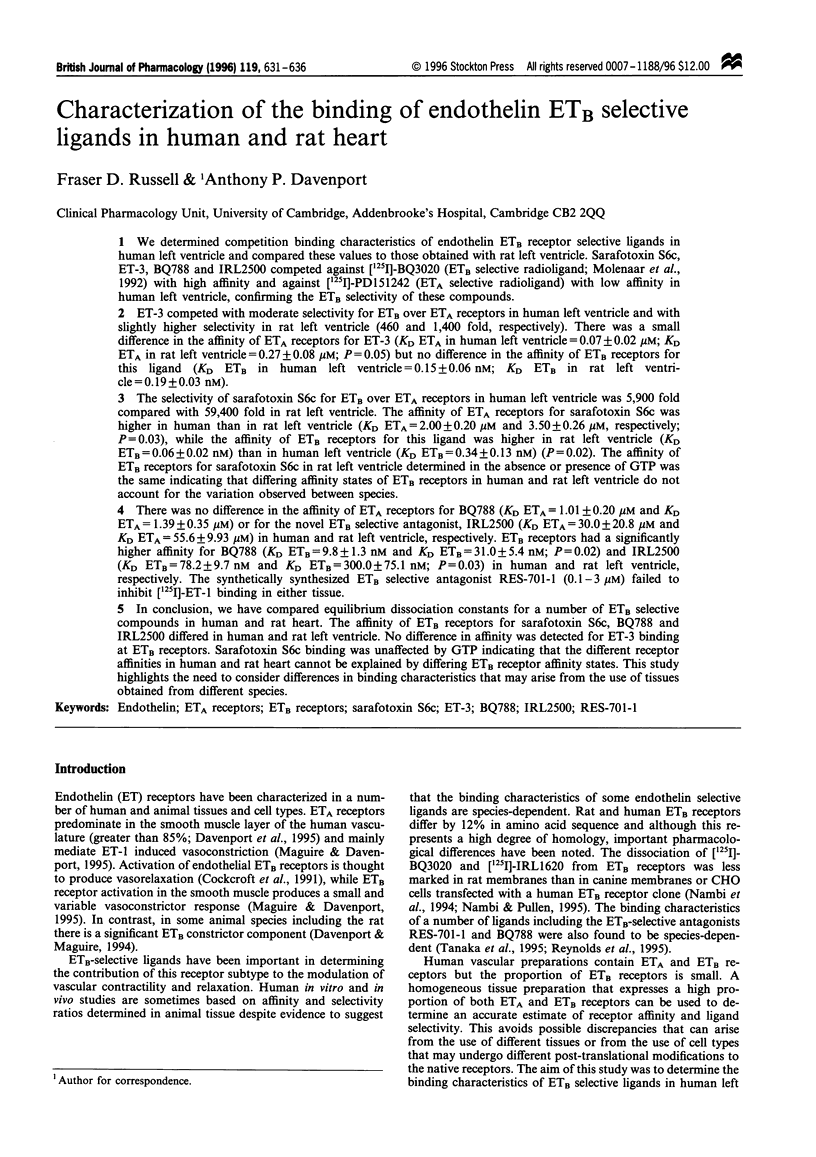
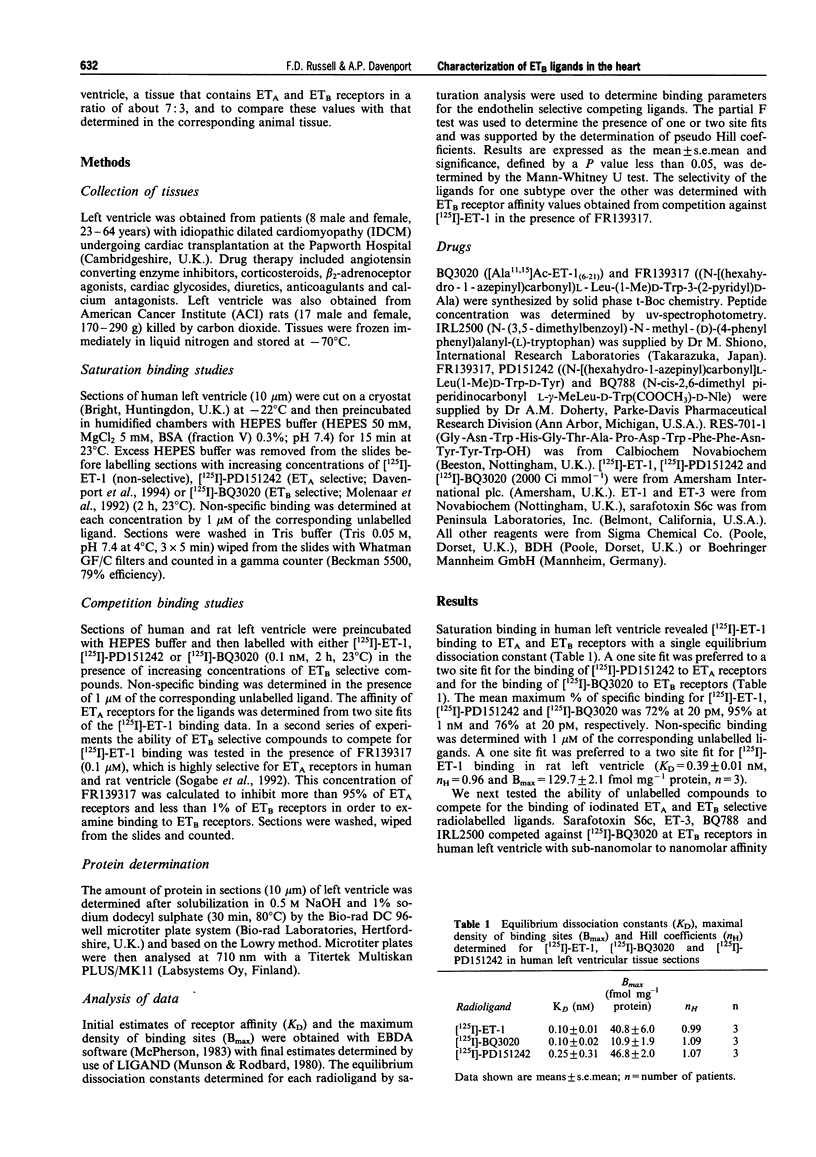
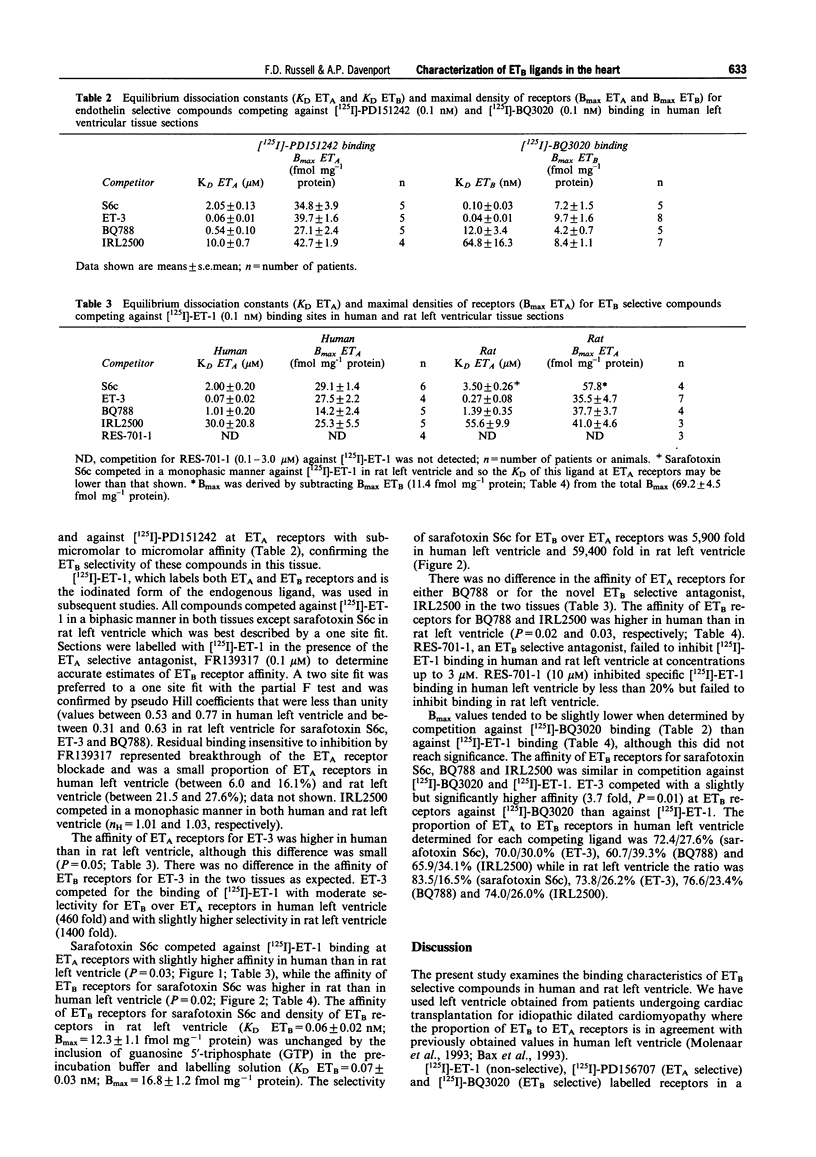
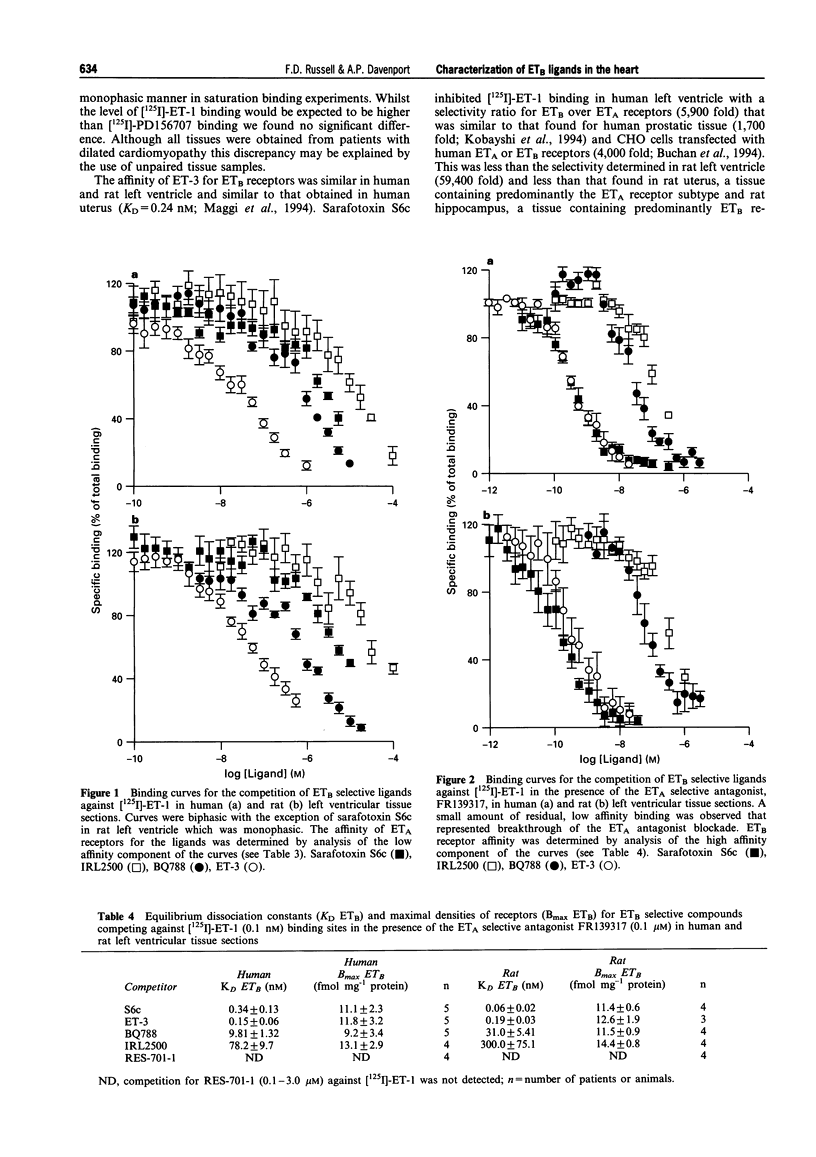

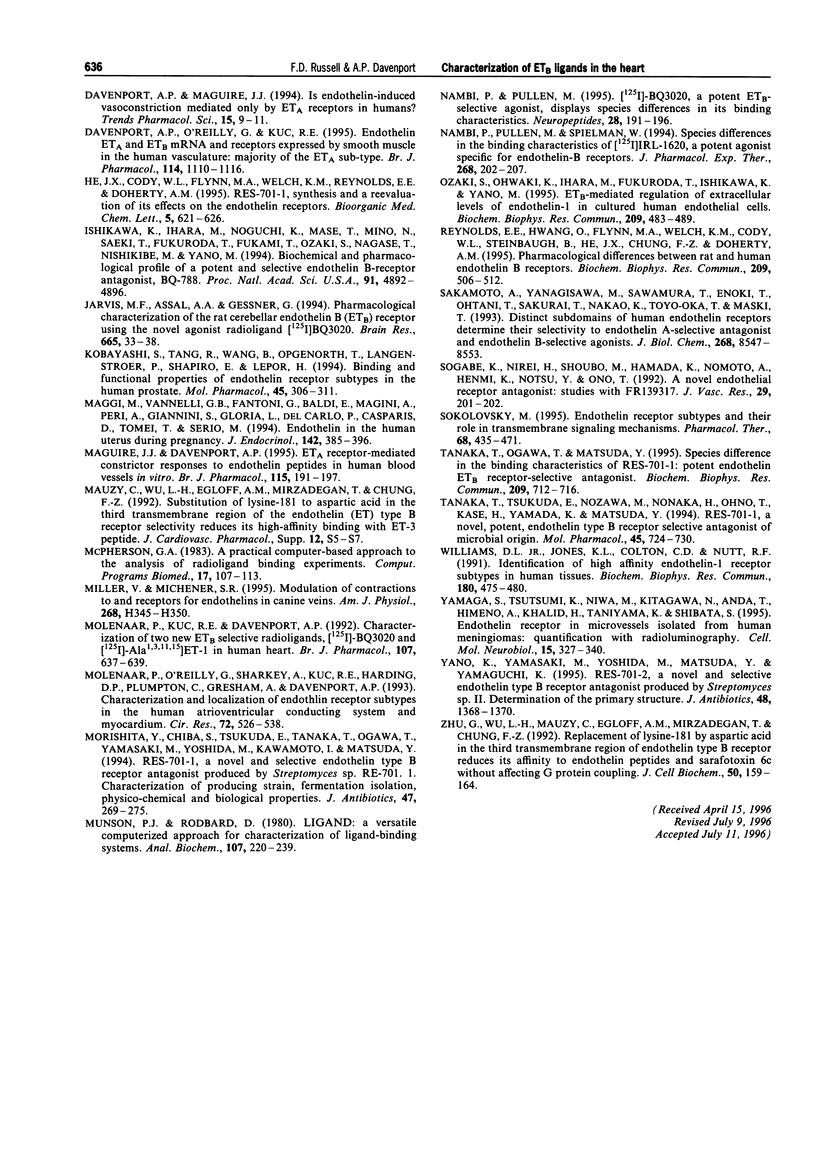
Selected References
These references are in PubMed. This may not be the complete list of references from this article.
- Akiyama N., Hiraoka O., Fujii Y., Terashima H., Satoh M., Wada K., Furuichi Y. Biotin derivatives of endothelin: utilization for affinity purification of endothelin receptor. Protein Expr Purif. 1992 Oct;3(5):427–433. doi: 10.1016/s1046-5928(05)80046-4. [DOI] [PubMed] [Google Scholar]
- Bax W. A., Bruinvels A. T., van Suylen R. J., Saxena P. R., Hoyer D. Endothelin receptors in the human coronary artery, ventricle and atrium. A quantitative autoradiographic analysis. Naunyn Schmiedebergs Arch Pharmacol. 1993 Oct;348(4):403–410. doi: 10.1007/BF00171340. [DOI] [PubMed] [Google Scholar]
- Becker A., Haendler B., Hechler U., Schleuning W. D. Mutational analysis of human endothelin receptors ETA and ETB identification of regions involved in the selectivity for endothelin 3 or cyclo-(D-Trp-D-Asp-Pro-D-Val-Leu). Eur J Biochem. 1994 May 1;221(3):951–958. doi: 10.1111/j.1432-1033.1994.tb18810.x. [DOI] [PubMed] [Google Scholar]
- Buchan K. W., Alldus C., Christodoulou C., Clark K. L., Dykes C. W., Sumner M. J., Wallace D. M., White D. G., Watts I. S. Characterization of three non-peptide endothelin receptor ligands using human cloned ETA and ETB receptors. Br J Pharmacol. 1994 Aug;112(4):1251–1257. doi: 10.1111/j.1476-5381.1994.tb13218.x. [DOI] [PMC free article] [PubMed] [Google Scholar]
- Cockcroft J. R., Clarke J. G., Webb D. J. The effect of intra-arterial endothelin on resting blood flow and sympathetically mediated vasoconstriction in the forearm of man. Br J Clin Pharmacol. 1991 May;31(5):521–524. doi: 10.1111/j.1365-2125.1991.tb05573.x. [DOI] [PMC free article] [PubMed] [Google Scholar]
- Davenport A. P., Maguire J. J. Is endothelin-induced vasoconstriction mediated only by ETA receptors in humans? Trends Pharmacol Sci. 1994 Jan;15(1):9–11. doi: 10.1016/0165-6147(94)90120-1. [DOI] [PubMed] [Google Scholar]
- Davenport A. P., O'Reilly G., Kuc R. E. Endothelin ETA and ETB mRNA and receptors expressed by smooth muscle in the human vasculature: majority of the ETA sub-type. Br J Pharmacol. 1995 Mar;114(6):1110–1116. doi: 10.1111/j.1476-5381.1995.tb13322.x. [DOI] [PMC free article] [PubMed] [Google Scholar]
- Ishikawa K., Ihara M., Noguchi K., Mase T., Mino N., Saeki T., Fukuroda T., Fukami T., Ozaki S., Nagase T. Biochemical and pharmacological profile of a potent and selective endothelin B-receptor antagonist, BQ-788. Proc Natl Acad Sci U S A. 1994 May 24;91(11):4892–4896. doi: 10.1073/pnas.91.11.4892. [DOI] [PMC free article] [PubMed] [Google Scholar]
- Jarvis M. F., Assal A. A., Gessner G. Pharmacological characterization of the rat cerebellar endothelin B (ETB) receptor using the novel agonist radioligand [125I]BQ3020. Brain Res. 1994 Nov 28;665(1):33–38. doi: 10.1016/0006-8993(94)91148-7. [DOI] [PubMed] [Google Scholar]
- Kobayashi S., Tang R., Wang B., Opgenorth T., Langenstroer P., Shapiro E., Lepor H. Binding and functional properties of endothelin receptor subtypes in the human prostate. Mol Pharmacol. 1994 Feb;45(2):306–311. [PubMed] [Google Scholar]
- Maggi M., Vannelli G. B., Fantoni G., Baldi E., Magini A., Peri A., Giannini S., Gloria L., Del Carlo P., Casparis D. Endothelin in the human uterus during pregnancy. J Endocrinol. 1994 Sep;142(3):385–396. doi: 10.1677/joe.0.1420385. [DOI] [PubMed] [Google Scholar]
- Maguire J. J., Davenport A. P. ETA receptor-mediated constrictor responses to endothelin peptides in human blood vessels in vitro. Br J Pharmacol. 1995 May;115(1):191–197. doi: 10.1111/j.1476-5381.1995.tb16338.x. [DOI] [PMC free article] [PubMed] [Google Scholar]
- McPherson G. A. A practical computer-based approach to the analysis of radioligand binding experiments. Comput Programs Biomed. 1983 Aug-Oct;17(1-2):107–113. doi: 10.1016/0010-468x(83)90031-4. [DOI] [PubMed] [Google Scholar]
- Miller V. M., Michener S. R. Modulation of contractions to and receptors for endothelins in canine veins. Am J Physiol. 1995 Jan;268(1 Pt 2):H345–H350. doi: 10.1152/ajpheart.1995.268.1.H345. [DOI] [PubMed] [Google Scholar]
- Molenaar P., Kuc R. E., Davenport A. P. Characterization of two new ETB selective radioligands, [125I]-BQ3020 and [125I]-[Ala1,3,11,15]ET-1 in human heart. Br J Pharmacol. 1992 Nov;107(3):637–639. doi: 10.1111/j.1476-5381.1992.tb14498.x. [DOI] [PMC free article] [PubMed] [Google Scholar]
- Molenaar P., O'Reilly G., Sharkey A., Kuc R. E., Harding D. P., Plumpton C., Gresham G. A., Davenport A. P. Characterization and localization of endothelin receptor subtypes in the human atrioventricular conducting system and myocardium. Circ Res. 1993 Mar;72(3):526–538. doi: 10.1161/01.res.72.3.526. [DOI] [PubMed] [Google Scholar]
- Morishita Y., Chiba S., Tsukuda E., Tanaka T., Ogawa T., Yamasaki M., Yoshida M., Kawamoto I., Matsuda Y. RES-701-1, a novel and selective endothelin type B receptor antagonist produced by Streptomyces sp. RE-701. I. Characterization of producing strain, fermentation, isolation, physico-chemical and biological properties. J Antibiot (Tokyo) 1994 Mar;47(3):269–275. doi: 10.7164/antibiotics.47.269. [DOI] [PubMed] [Google Scholar]
- Munson P. J., Rodbard D. Ligand: a versatile computerized approach for characterization of ligand-binding systems. Anal Biochem. 1980 Sep 1;107(1):220–239. doi: 10.1016/0003-2697(80)90515-1. [DOI] [PubMed] [Google Scholar]
- Nambi P., Pullen M., Spielman W. Species differences in the binding characteristics of [125I]IRL-1620, a potent agonist specific for endothelin-B receptors. J Pharmacol Exp Ther. 1994 Jan;268(1):202–207. [PubMed] [Google Scholar]
- Nambi P., Pullen M. [125I]-BQ3020, a potent ETB-selective agonist, displays species differences in its binding characteristics. Neuropeptides. 1995 Mar;28(3):191–196. doi: 10.1016/0143-4179(95)90115-9. [DOI] [PubMed] [Google Scholar]
- Ozaki S., Ohwaki K., Ihara M., Fukuroda T., Ishikawa K., Yano M. ETB-mediated regulation of extracellular levels of endothelin-1 in cultured human endothelial cells. Biochem Biophys Res Commun. 1995 Apr 17;209(2):483–489. doi: 10.1006/bbrc.1995.1527. [DOI] [PubMed] [Google Scholar]
- Reynolds E. E., Hwang O., Flynn M. A., Welch K. M., Cody W. L., Steinbaugh B., He J. X., Chung F. Z., Doherty A. M. Pharmacological differences between rat and human endothelin B receptors. Biochem Biophys Res Commun. 1995 Apr 17;209(2):506–512. doi: 10.1006/bbrc.1995.1530. [DOI] [PubMed] [Google Scholar]
- Sakamoto A., Yanagisawa M., Sawamura T., Enoki T., Ohtani T., Sakurai T., Nakao K., Toyo-oka T., Masaki T. Distinct subdomains of human endothelin receptors determine their selectivity to endothelinA-selective antagonist and endothelinB-selective agonists. J Biol Chem. 1993 Apr 25;268(12):8547–8553. [PubMed] [Google Scholar]
- Sokolovsky M. Endothelin receptor subtypes and their role in transmembrane signaling mechanisms. Pharmacol Ther. 1995;68(3):435–471. doi: 10.1016/0163-7258(95)02015-2. [DOI] [PubMed] [Google Scholar]
- Tanaka T., Ogawa T., Matsuda Y. Species difference in the binding characteristics of RES-701-1: potent endothelin ETB receptor-selective antagonist. Biochem Biophys Res Commun. 1995 Apr 17;209(2):712–716. doi: 10.1006/bbrc.1995.1557. [DOI] [PubMed] [Google Scholar]
- Tanaka T., Tsukuda E., Nozawa M., Nonaka H., Ohno T., Kase H., Yamada K., Matsuda Y. RES-701-1, a novel, potent, endothelin type B receptor-selective antagonist of microbial origin. Mol Pharmacol. 1994 Apr;45(4):724–730. [PubMed] [Google Scholar]
- Williams D. L., Jr, Jones K. L., Colton C. D., Nutt R. F. Identification of high affinity endothelin-1 receptor subtypes in human tissues. Biochem Biophys Res Commun. 1991 Oct 31;180(2):475–480. doi: 10.1016/s0006-291x(05)81089-7. [DOI] [PubMed] [Google Scholar]
- Yamaga S., Tsutsumi K., Niwa M., Kitagawa N., Anda T., Himeno A., Khalid H., Taniyama K., Shibata S. Endothelin receptor in microvessels isolated from human meningiomas: quantification with radioluminography. Cell Mol Neurobiol. 1995 Jun;15(3):327–340. doi: 10.1007/BF02089943. [DOI] [PubMed] [Google Scholar]
- Yano K., Yamasaki M., Yoshida M., Matsuda Y., Yamaguchi K. RES-701-2, a novel and selective endothelin type B receptor antagonist produced by Streptomyces sp. II. Determination of the primary structure. J Antibiot (Tokyo) 1995 Nov;48(11):1368–1370. doi: 10.7164/antibiotics.48.1368. [DOI] [PubMed] [Google Scholar]
- Zhu G., Wu L. H., Mauzy C., Egloff A. M., Mirzadegan T., Chung F. Z. Replacement of lysine-181 by aspartic acid in the third transmembrane region of endothelin type B receptor reduces its affinity to endothelin peptides and sarafotoxin 6c without affecting G protein coupling. J Cell Biochem. 1992 Oct;50(2):159–164. doi: 10.1002/jcb.240500206. [DOI] [PubMed] [Google Scholar]


